The museum of Cluny (Paris)
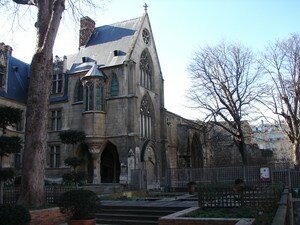 The
palate of the Thermal baths of Cluny, which was used at the same time
as citadel, was built, according to any probability, when Constance Chlorinates, the cesar of Gaules, the conqueror of
England, which lived in Lutèce from 287 to 292 after Jesus-Christ, was emperor.
The
palate of the Thermal baths of Cluny, which was used at the same time
as citadel, was built, according to any probability, when Constance Chlorinates, the cesar of Gaules, the conqueror of
England, which lived in Lutèce from 287 to 292 after Jesus-Christ, was emperor.
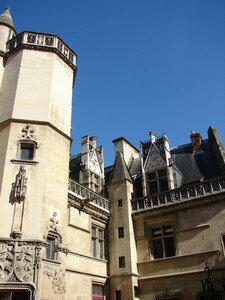 In year 360, césar Julien the Apostate was in this same place proclaimed emperor, by the army and the people
and it attached his fame to it, because it is called commonly the
Thermal baths of Julien. One owed well him this honor in recognition of
the particular attachment which it had for “its dear Lutèce”. After
him, the Valentinien emperors and Gratien spent the winter of 365
there.
In year 360, césar Julien the Apostate was in this same place proclaimed emperor, by the army and the people
and it attached his fame to it, because it is called commonly the
Thermal baths of Julien. One owed well him this honor in recognition of
the particular attachment which it had for “its dear Lutèce”. After
him, the Valentinien emperors and Gratien spent the winter of 365
there.
 Leaned
two-track Romans: the main road of the South, whose layout is indicated
today by the street and the Saint-Jacob suburb, and another whose
substructions were discovered in 1839 pennies the ground of the street
of the Toothing-stone, now represented by the Eastern side of the
boulevard the Michaelmas, the imperial palate was to present at midday
its principal frontage, in front of which to the street Soufflot the
campus extended or places of weapons.
Leaned
two-track Romans: the main road of the South, whose layout is indicated
today by the street and the Saint-Jacob suburb, and another whose
substructions were discovered in 1839 pennies the ground of the street
of the Toothing-stone, now represented by the Eastern side of the
boulevard the Michaelmas, the imperial palate was to present at midday
its principal frontage, in front of which to the street Soufflot the
campus extended or places of weapons.
 Side
of the west, it dominated of immense gardens prolonged until the
current site of Saint-Germain-des-Prés, and to the Seine on the
northern side.
Side
of the west, it dominated of immense gardens prolonged until the
current site of Saint-Germain-des-Prés, and to the Seine on the
northern side.
 The
palate of the thermal baths will be built on the model of all the great
establishments of public baths established then in the capitals of the
Roman Empire: a hot room (caldacium), a tepid room (tepidarium), a cold
room (frigidarium). One allots his construction to the powerful
corporation of Nautes of Paris, which held the monopoly of water. It
was fed out of water by the Roman aqueduct of Arcueil, and was equipped
with sewers and the underground corridors, oldest of Paris. It will be
used as refuge with Parisian during the successive invasions of Huns
and the Norman ones.
The
palate of the thermal baths will be built on the model of all the great
establishments of public baths established then in the capitals of the
Roman Empire: a hot room (caldacium), a tepid room (tepidarium), a cold
room (frigidarium). One allots his construction to the powerful
corporation of Nautes of Paris, which held the monopoly of water. It
was fed out of water by the Roman aqueduct of Arcueil, and was equipped
with sewers and the underground corridors, oldest of Paris. It will be
used as refuge with Parisian during the successive invasions of Huns
and the Norman ones.
 The
merovingian king Childebert still lived it and the poet Fortunat sang
of it the magnificence at the beginning of VIIth century. The
carlovingians emperors, who usually resided in Aachen, gave up the palate of
Paris; the Alcuin English, who was like the minister of Charlemagne for
the development of the education state, there establishes, says one, a
school or rather a workshop of manuscripts and miniatures.
The
merovingian king Childebert still lived it and the poet Fortunat sang
of it the magnificence at the beginning of VIIth century. The
carlovingians emperors, who usually resided in Aachen, gave up the palate of
Paris; the Alcuin English, who was like the minister of Charlemagne for
the development of the education state, there establishes, says one, a
school or rather a workshop of manuscripts and miniatures.
 The current ruins represent only one third of the vast Gallo-Roman
building undoubtedly built by the powerful corporation of the Parisian
nautes. The Thermal baths consisted of spaces for the baths like the
caldarium (hot room), tepidarium (room tepid) and frigidarium (cold
room), or of the common parts and services. Undergrounds fed the system
of heating (hypocaustes) allowing a drainage in the Seine. The supply
water was ensured by a long aqueduct of almost 15 kilometers directly
connected to the plain of Rungis. The Thermal baths were ransacked and
set fire to by the barbarians at the end of IIIth century.
The current ruins represent only one third of the vast Gallo-Roman
building undoubtedly built by the powerful corporation of the Parisian
nautes. The Thermal baths consisted of spaces for the baths like the
caldarium (hot room), tepidarium (room tepid) and frigidarium (cold
room), or of the common parts and services. Undergrounds fed the system
of heating (hypocaustes) allowing a drainage in the Seine. The supply
water was ensured by a long aqueduct of almost 15 kilometers directly
connected to the plain of Rungis. The Thermal baths were ransacked and
set fire to by the barbarians at the end of IIIth century.
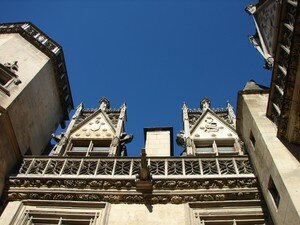 The
construction of the enclosure of Philippe-Auguste, while inserting in
the city the vast gardens of the palate, which one called the Field of
Laas, i.e. of the citadel (in Latin arx, as old French Li ars),
determined the allotment and the parcelling out of it. The districts
Saint-Andre-of-Arts, to the Hautefeuille street and the street of
School-of-Medicine, are formed at the expense of the old gardens of the
old palate. It was whereas Philippe-Auguste, by a charter of 1218, made
gift to his chamberlain of the palate itself, Henri, tiny room to the
state of rural field, because it contained a press
The
construction of the enclosure of Philippe-Auguste, while inserting in
the city the vast gardens of the palate, which one called the Field of
Laas, i.e. of the citadel (in Latin arx, as old French Li ars),
determined the allotment and the parcelling out of it. The districts
Saint-Andre-of-Arts, to the Hautefeuille street and the street of
School-of-Medicine, are formed at the expense of the old gardens of the
old palate. It was whereas Philippe-Auguste, by a charter of 1218, made
gift to his chamberlain of the palate itself, Henri, tiny room to the
state of rural field, because it contained a press
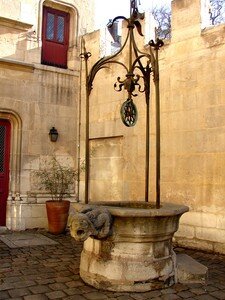 About
1330, Pierre de Châlus, abbot of Cluny-in-Burgundy, buy the ruins and
the grounds bordering to built there an hotel intended for the abbots
come to the college which it has just founded close to the Sorbonne.
Rebuilt by Jacques d' Ambois, bishop
About
1330, Pierre de Châlus, abbot of Cluny-in-Burgundy, buy the ruins and
the grounds bordering to built there an hotel intended for the abbots
come to the college which it has just founded close to the Sorbonne.
Rebuilt by Jacques d' Ambois, bishop
of Clermont at the end of XIIIth
century, this private residence of XVth still comprises medieval
elements the such turrets receiving the staircases or the battlements
on the covered way but it precede also the future Parisian private
mansions with a building built on a plan out of U and a body of the
home between court and garden. The hotel accomodates Marie of England,
widow of Louis XII, in 1515 then the nuncios of the pope in the XVIIth
century.
 During
the Revolution, the hotel is issued quite national. It is sold and in
1833, Alexandre of Sommerard comes to place in Cluny and installs there
a collection of art objets of the Middle Ages and Rebirth. Lastly,
when the State went purchaser, after the death of Mr. of Sommerard, the
admirable collection formed by this antique dealer in the hotel of
Cluny, the town of Paris offered in pure gift the ruins of the palate
of the Thermal baths, and the new museum was consisted the law of July
24, 1843 under the name of museum of the Thermal baths and the Cluny
hotel.
During
the Revolution, the hotel is issued quite national. It is sold and in
1833, Alexandre of Sommerard comes to place in Cluny and installs there
a collection of art objets of the Middle Ages and Rebirth. Lastly,
when the State went purchaser, after the death of Mr. of Sommerard, the
admirable collection formed by this antique dealer in the hotel of
Cluny, the town of Paris offered in pure gift the ruins of the palate
of the Thermal baths, and the new museum was consisted the law of July
24, 1843 under the name of museum of the Thermal baths and the Cluny
hotel.
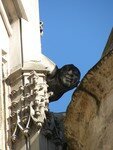 The
entry of the Hotel of Cluny is street of Sommerard, in which one
penetrates by a door in surbased arch. The frontage of the abbey hotel
is composed of a large main building flanked of two wings, and divided
in its line of centers by a large turret with cut sides.
The
entry of the Hotel of Cluny is street of Sommerard, in which one
penetrates by a door in surbased arch. The frontage of the abbey hotel
is composed of a large main building flanked of two wings, and divided
in its line of centers by a large turret with cut sides.
 The
frontage and the turret are surmounted by an up to date gallery behind
which high richly carved attic windows rise, and whose tympanums
represent the escutcheons, the badges and the currencies of the family
of Amboise. The left wing, while entering the court, is bored of four
ogival arcades which give access in a room communicating to the palate
Thermal baths.
The
frontage and the turret are surmounted by an up to date gallery behind
which high richly carved attic windows rise, and whose tympanums
represent the escutcheons, the badges and the currencies of the family
of Amboise. The left wing, while entering the court, is bored of four
ogival arcades which give access in a room communicating to the palate
Thermal baths.
 The
walls are those of a Roman construction, whose antique cover was
altered only in 1737. One replaced it in the last years. The right wing
formerly contained the kitchens and the offices. The well, located in
the angle of the court, preserved its old and artistic fitting. In the
opposed angle, joining the principal frontage, the entry of the museum
and its collections is.
The
walls are those of a Roman construction, whose antique cover was
altered only in 1737. One replaced it in the last years. The right wing
formerly contained the kitchens and the offices. The well, located in
the angle of the court, preserved its old and artistic fitting. In the
opposed angle, joining the principal frontage, the entry of the museum
and its collections is.
 Around
the buildings, side of the street of Cluny and on the large
septentrional frontage that skirts the Saint-Germain boulevard, a green
garden spreads its freshness and its shade on the stone monuments,
statues, columns, pilasters, low-reliefs, inscriptions, furnace bridges
and tomb stones which in the open air double the interior collections
of a museum. It is there that one rebuilt the gate of the Saint-Benoît
church, found under the false frontage of the theatre of the Pantheon,
demolished by the passage of the street of the Schools.
Around
the buildings, side of the street of Cluny and on the large
septentrional frontage that skirts the Saint-Germain boulevard, a green
garden spreads its freshness and its shade on the stone monuments,
statues, columns, pilasters, low-reliefs, inscriptions, furnace bridges
and tomb stones which in the open air double the interior collections
of a museum. It is there that one rebuilt the gate of the Saint-Benoît
church, found under the false frontage of the theatre of the Pantheon,
demolished by the passage of the street of the Schools.
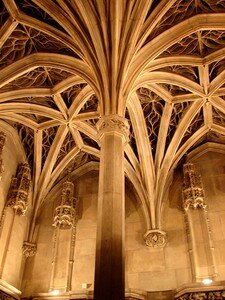 The vault contiguous to this room also preserves its vaults at fine
veins, falling down in beams on a central pillar, supporting that of
the first stage, and which supports a vault with the ogival arcades; it
is surmounted by a capital carrying K (Karolus) crowned of the king
Charles VIII, and them weapons of the family of Amboise; one considers
it, according to the expression of Mr. E. of Sommerard, as the stone of
dedication of the building.
The vault contiguous to this room also preserves its vaults at fine
veins, falling down in beams on a central pillar, supporting that of
the first stage, and which supports a vault with the ogival arcades; it
is surmounted by a capital carrying K (Karolus) crowned of the king
Charles VIII, and them weapons of the family of Amboise; one considers
it, according to the expression of Mr. E. of Sommerard, as the stone of
dedication of the building.
 Today
the rooms of the palate of the Thermal baths are filled with
sculptures, statues, low-reliefs, votive ornaments, etc, drawn either
from the Parisian ground, or of old monuments coming from the old
provinces: Roman antiquities, remains of the Middle Ages and the
Rebirth, sad wrecks of our religious, political or only municipal
revolutions. It is in the large room of frigidarium that the curious
ones about Parisian antiquities can contemplate the oldest monuments
discovered on the ground of Lutèce; they are the four high Gallo-Roman
furnace bridges with Jupiter by Nautes or body of the marines of
Lutèce, under the Tibère emperor, who date consequently from the 1st
century of the Christian era and were found on May 16, 1711, as we
already said, in the foundations of a very old wall who crossed north
to the south the chorus of Notre-Dame, by the workmen charged to dig
the site of a vault for the burial of the archbishops of Paris.
Today
the rooms of the palate of the Thermal baths are filled with
sculptures, statues, low-reliefs, votive ornaments, etc, drawn either
from the Parisian ground, or of old monuments coming from the old
provinces: Roman antiquities, remains of the Middle Ages and the
Rebirth, sad wrecks of our religious, political or only municipal
revolutions. It is in the large room of frigidarium that the curious
ones about Parisian antiquities can contemplate the oldest monuments
discovered on the ground of Lutèce; they are the four high Gallo-Roman
furnace bridges with Jupiter by Nautes or body of the marines of
Lutèce, under the Tibère emperor, who date consequently from the 1st
century of the Christian era and were found on May 16, 1711, as we
already said, in the foundations of a very old wall who crossed north
to the south the chorus of Notre-Dame, by the workmen charged to dig
the site of a vault for the burial of the archbishops of Paris.
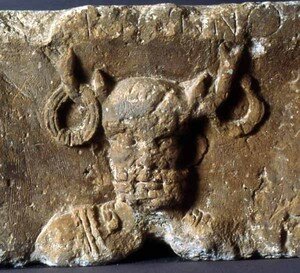 The
first of these furnace bridges is composed of two sitted superimposed
and forms a square cippe representing Jupiter, Vulcan, the Gallic Mars
or Esus, gathering the crowned GUI, and a bull carrying three cranes,
with this inscription: TARVOS (FOR TAURUS) TRIGARANUS. The second
furnace bridge is decorated, on three faces, of figures and rough
inscriptions.
The
first of these furnace bridges is composed of two sitted superimposed
and forms a square cippe representing Jupiter, Vulcan, the Gallic Mars
or Esus, gathering the crowned GUI, and a bull carrying three cranes,
with this inscription: TARVOS (FOR TAURUS) TRIGARANUS. The second
furnace bridge is decorated, on three faces, of figures and rough
inscriptions.
One of these stones contains the important inscription which is reproduced below:
TIB. CAESARE
AVG. I0VI. OPTVMO
MAXSVMO….M (ARAM)
NAVTAE. PARISIACI.
PVBLICE. POSIERVNT.
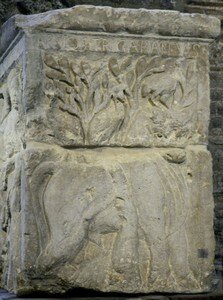 I.e.:
“Under the reign of Tibère César Auguste, in excellent and very large
Jupiter, NaUtes Parisian posed this furnace bridge publicly. ” It is
thus proven that, as of the beginning of the Christian era, four
centuries before the foundation of monarchy, it existed in Paris a
company of navigators or fluviatile traders, that it is plausible to
regard as the ancestors of the Parisian municipality.
I.e.:
“Under the reign of Tibère César Auguste, in excellent and very large
Jupiter, NaUtes Parisian posed this furnace bridge publicly. ” It is
thus proven that, as of the beginning of the Christian era, four
centuries before the foundation of monarchy, it existed in Paris a
company of navigators or fluviatile traders, that it is plausible to
regard as the ancestors of the Parisian municipality.
 The
third furnace bridge represents on a side the figure of Pollux, armed
with the lance and overcoming a horse; opposed side, a similar figure,
but without name, which must be Castor; on the third face, a bearded
old man, whose face bald person is armed with two horns of stag in
which passed from the rings. It is the god CERNUNNOS, to whom
Guilhermy, the Parisian archaeologist par excellence, lent a purely
imaginary mysterious character; because it is the very legitimate name
of horned Bacchus (in Greek horn) who is in several gallo-Latin
inscriptions collected by Forcellini; the fourth face represents the
profile of a man, perhaps Hercules, holding up a bludgeon on the head
of a snake. The fourth furnace bridge is as mutilated in its figures as
in its inscriptions.
The
third furnace bridge represents on a side the figure of Pollux, armed
with the lance and overcoming a horse; opposed side, a similar figure,
but without name, which must be Castor; on the third face, a bearded
old man, whose face bald person is armed with two horns of stag in
which passed from the rings. It is the god CERNUNNOS, to whom
Guilhermy, the Parisian archaeologist par excellence, lent a purely
imaginary mysterious character; because it is the very legitimate name
of horned Bacchus (in Greek horn) who is in several gallo-Latin
inscriptions collected by Forcellini; the fourth face represents the
profile of a man, perhaps Hercules, holding up a bludgeon on the head
of a snake. The fourth furnace bridge is as mutilated in its figures as
in its inscriptions.
Far from being a place crowned at the beginning, the museum became by the significant number of crowned objects themselves which it contains. Among them, a black virgin coming from Auvergne, some beautiful parts of representation of the Christian goddess-mother. One of them carries even holes on will chakras. The famous tapestry of the lady to the unicorn is the subject of an article with whole share.
http://www.paris-pittoresque.com/monuments/28b.htm

/https%3A%2F%2Fprofilepics.canalblog.com%2Fprofilepics%2F1%2F1%2F116167.jpg)
/https%3A%2F%2Fstorage.canalblog.com%2F49%2F16%2F312499%2F14620054_o.jpg)
/https%3A%2F%2Fstorage.canalblog.com%2F53%2F18%2F312499%2F14151229_o.jpg)
/https%3A%2F%2Fstorage.canalblog.com%2F07%2F05%2F312499%2F14149867_o.jpg)
/https%3A%2F%2Fstorage.canalblog.com%2F11%2F35%2F312499%2F14149307_o.jpg)
/https%3A%2F%2Fstorage.canalblog.com%2F90%2F14%2F312499%2F14125247_o.jpg)


/https%3A%2F%2Fstorage.canalblog.com%2F12%2F98%2F137895%2F6624411_p.jpg)
/https%3A%2F%2Fstorage.canalblog.com%2F34%2F82%2F137895%2F27207854_p.jpg)
/https%3A%2F%2Fstorage.canalblog.com%2F32%2F37%2F137895%2F15872299_p.jpg)
/https%3A%2F%2Fstorage.canalblog.com%2F37%2F81%2F137895%2F15879822_p.jpg)